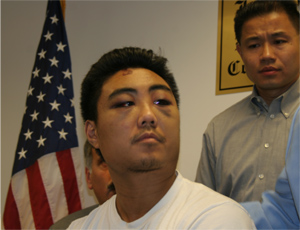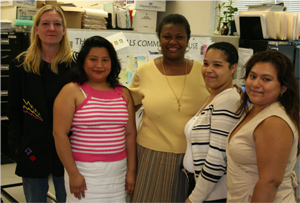By Maurice Pinzon
According to the Queens District Attorney’s office four young Asian men were attacked by two young white men in Northeast Queens a couple of hours after midnight last Saturday morning. Three of the victims attended a news conference yesterday at New York City Council member John C. Liu’s office in Flushing.
Council member Liu described the scene: “These boys were driving along Northern Boulevard, in Northeast Queens, when another car pulled alongside them. Racial epithets were hurled, and it led to their car being rear ended by the suspects, who then got out of the car and started to physically attack these teens.”
At the news conference the young men appeared stunned. Reynold Liang, 19, was the most severely injured. He was the driver of the Lexus that was hit by the 1998 Toyota driven by the two young white men.
Mr. Liang said he stopped the Lexus to inspect the damage but the two white young men had followed his car. When he jumped out of the car to defend his friends, he said, “I got tackled down and I was beaten. I was hit like 30 or 40 times.”
According to the D.A.’s office and Mr. Liang, he was also hit with his own steering wheel security device known as “The Club”.
Mr. Liang, with his eyes almost completely shut from swelling, also had black and blue marks around his eyes and along the left side of his neck. As his eyes glittered during the constant flashing of news photographers’ cameras, it was unclear if his eyes were tearing or if they were reflecting the light from the flashes.
Mr. Liang, a lifelong resident of Queens, attended Brooklyn Technical High School and is currently enrolled at the State University of New York at Stony Brook.
He spoke softly, almost forcing the words out of his mouth as he responded to questions. Just before speaking to the reporters, he told Council member Liu that he thought it was important to speak out about what had happened to him and his friends.
Mr. Liang said, “I was very angry ’cause this happened, like, to my neighborhood, two blocks away from my house.” He said he was “very upset.”
Mr. Liang said nothing even remotely similar had ever happened to him before. He had never ever been called a racial slur. Although he now was bruised, during the incident he said he felt no pain because he wanted to defend himself and his friends. Mr. Liang said he was initially immobilized when his two attackers shouted racial slurs at him.
“I felt completely defenseless afterwards,” he added.
John Lu, a friend of Mr. Liang’s who was also in the car early Saturday morning, is also a lifelong Queens resident. He attended Benjamin N. Cardozo High School in Bayside and is now a student at the State University of New York at Albany.
He said, “Something like this has like never actually happened to me.” Mr. Lu said he loves his neighborhood of Little Neck.
Indeed all three of the Asian youths said none of them had ever experienced anything like what had happened to them last weekend. David Wu, who was also at the news conference and had been with Mr. Liang and Mr. Lu in the car, said he had been called names, but in the Bronx – never in Queens.
A few blocks away from Council member Liu’s district office in downtown Flushing, young boys and girls mingled just outside the Flushing Library, a place always teeming with young and old people entering and exiting the building.
One of them was Jason Wang, 16, who had just spent some time there preparing for his SAT exams. He said he was studying hard because he wanted to attend Columbia University or St. John’s University to major in Pharmacy.
Mr. Wang was interested in finding out the details of the attack on the Asian youths in Queens. He had heard about it but was not concerned for his own safety because he said he lived in Fresh Meadows, a quiet neighborhood where mostly seniors reside. He also said he believed nothing would likely happen to him when he visited the library to study.
“This is Flushing,” Mr. Wang said.


